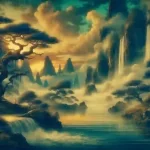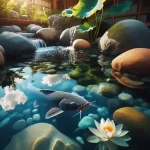(I)
The history of Assamese literature is traced from the thirteenth century. Much of the early productions of this literature is religious in tone and verse in form. The poets based their work on the Sanskrit Puranas, borrowing the themes and giving them a vernacular treatment. The narration is free and easy and often informed with a dialectal tang. There is not much scope here for the communication of personal feelings and sentiments, but as the theme is religious, the attitude of devotion occasionally lends the verse a lyrical tone. The attitude of devotion may sometimes be the lover’s attitude, as in the case of Chandidas of Bengal, but in Assam the dasya mode of bhakti allowed no such freedom: it was a more restrained system and did not make for the nourishment of songs of a lyrical type.
The first major poet is Madhav Kandali of the fourteenth century. His magnum opus was the translation of the Ramayana. Madhav Kandali was a scholar but wanted to write “in the idiom of the people.” The translation, which is rather free, is competent, and repays study for the number of idioms and racy expressions it contains. The translator further had a real poetical instinct and was accorded high praise by Sankardev, the greatest medieval poet of Assam.
Sankardev was born in 1449 and lived up to 1469. It was with the rise of this Vaisnavite preacher, poet, playwright and musician that Assamese literature came to its own. Sankardev had an able lieutenant in Madhavdev, equally versatile, and a host of followers who also took to the pen in the cause of religion. Sankardev wrote a few plays in the vernacular and these contain songs. These as well as those songs written on independent occasions are more lyrical than the general run of narrative produced in this period. Madhavdev also wrote songs and some intensely devotional verses. The nature of the religious lyricism of the times may be illustrated from Sankardev who in beauty of language and expressive power usually excelled. The following translation evidences a typical Indian symbolism and at same time a fairly universal mood:
This world is a dense forest,
Full of the fetters of desire,
And myself, a weakling of a deer,
Wandering here alone.
Time, like a hunter,
Charges at me fast.
I am entrapped in the fetters of Maya.
O Hari, I have lost heart,
And know not the way to salvation….
Sankardev’s Kirtan, a collection of stories exemplifying supremacy of Krishna, has secured its popularity not because it satisfies a spiritual thirst but because of the ease of narration and beauty of language. There is a zest and brilliance in this description of Krishna as the enchantress out to seduce Hara:
Like burnt gold her body shines unparalleled,
Graceful and developed are her hands and feet,
Her eyes, petals of the lotus, a ravishing smile on her lips,
Repeatedly does she reveal a coquettish manner….
Her high shignon loosens, drops her cluster of flowers,
She manages that with her left hand.
On her ears hang eardrops, her breasts shake,
On her neck a gold wreath shines.
One hears the tinkling that her gold bangles make,….
On her neck shakes the seven-rolled chain,
She sets her steps with grace and ease,
Seeming to step forward she moves backwards,
Putting on her sari with some air, as if a peacock spreads its fan,
She casts her eyes sideways at Hara…..
Ramsaraswati translated the Mahabharata, a stupendous task, and wrote few Kavyas on themes borrowed from the great epic. These may be characterized as allegories showing the victory of good over evil. In their narrative power and romantic tone they may remind one of the works of Spencer and William Morris.
Most of the verse produced by these Vaisnavite poets was in the pada metre of fourteen syllables with a caesura at the end of the eighth. This couplet like metre was found suitable for the narration of events, but an occasional diversion was made in favour of shorter lines and quatrains with a lighter rhythm.
(II)
The tradition of the Vaisnavite period survived till the Burmese in vasions and the entry of the British in the early part of the last century. In later times even histories of the land, which had been written in prose, came to be experimented with in the pada metre. A new poetry had its seeds planted in the Orunodoi Sambad Patra founded by the American Baptist Mission in 1846. Secularism and the personal note entered the literary scene and the modern lyric came to be accepted as a regular form.
The first poem printed in the Orunodoi was two quatrains on the evils of opium: “A very bad thing is opium, whoever takes it is extremely ignorant,…” Assamese writers took to the new genre and by the nineties could produce work of considerable merit. In 1889 was founded the Jonaki monthly by three students studying in Calcutta. These pioneers: Lakshminath Bezbarua, Chandrakumar Agarwalla and Hemchandra Goswami, had to write in various literary forms, but they excelled also as poets. Bezbarua was first a satirist and reformer, but he produced a few moving patriotic poems. His Veen-boragi or Mendicant with a Lute sings in a language not understandable, but in a melody that is familiar, for it sings of the poet’s land of birth. Agarwalla’s Boragi aru Veen or The Mendicant and the Lute sings of humanity at large, of its corruptions and cruelties, and the way to its moral regeneration: The Shelleyan intensity of passion that is seen in this long poem was something fresh in Assamese poetry:
Let the day of destruction come.
Scaring the sinful,
Let not there be land or water, highland or low-land,
Joy and sorrow, sighs of suffering.
Could I finger my lute strings well
I would pull down and
Cover the Himalayan peaks
With the churned up sea.
Scatter the stars of the skies
Lakhs in each handful,
Throw away the planets
By the cluster,
The floor of sin immerse
In the bottomless sea,
The vestige of the universe then
Only in the expanse of the ocean remain.
Blank verse and the sonnet were introduced about this time. An attempt was made to even translate the first book of Milton’s Paradise Lost. Hemchandra Goswami’s sonnets described “the beauties of the sweetheart” and the lyric of love came to be popular. The patriotic inspiration was however strong in a land which had lost its independence within living memory. The romantic love and personification of Nature also inspired poets like Agarwalla. These pioneers deserve credit for reintroducing in literature the spirit and language of the folksongs of the countryside. The Mendicant of Bezbarua sings of patriotism and that of Agarwalla sings of the sufferings of humanity. It should be added in this connection that some of the best lyricism of Assamese poetry is to be seen in the Bihu-nam, songs sung at the Bihu festival of the New Year.
The Bihu songs must have been old in inspiration but as we find them today they are modern in language, though the imagery and the style of composition are suited to a comparatively primitive and agricultural community. They have a lightness of touch that is rare in sophisticated verse:
One plays the pipe with three fingers
The middle one presses
If our dancer starts dancing
Like a butterfly she races.
This yellow bird with lovely plumes
Once it escapes it cannot be caught
This youth if it goes down-current
No more is to be had.
On the other bank of the Luit Kahuwa reeds have blossomed
Miri girls are sporting there
This month of Phagun your breasts have blossomed
My mind is sporting there.
My mind settles not at home, dear
Nor does it settle in the field
As the teased cotton floats
So to float do I long.
The early part of the present century saw the rise of several poets of considerable merit. Raghunath Chowdhury developed further the Nature mysticism of Chandrakumar Agarwalla and wrote in Keteki a superb poem by making a bird symbolise a message of sympathy and love and the awakening pulsating through the universe….Chowdhury’s Phul-sajya or Bridal Couch, a poem expressive of bitter suffering, has typically Indian imagery:
The full cup of joy is empty today
There’s only an outery on all sides—
In the heat of the forest fire
Burnt to ashes are the deodars.
The most well known lyricist of the twenties and thirties is Jatindranath Dowerah who translated the Rubayyats of Khayyam, wrote some prose-poems, and sang in limpid verse the futility of life where love and friendship was valueless. His cloying pessimism had a considerable following among the young till before the war. Suryyakumar Bhuyan’s lyricism had more thought content and Sailadhar Rajkhowa’s poetry considerable music. Among poets of the thirties, Ganesh Gogoi’s love poems have not lost their freshness, and the Vedantic mysticism of Nalinibala Devi still has an appeal.
The thirties and forties were primarily fruitful in lyrics of love, mostly derivative and acquiring a new conventionality. Devakanta Barua, however, struck a fresh note by absorbing a Browningesque technique and looking for fresh images, as in poems like Sagar Dekhisa? (Have You Seen the Ocean?). The patriotic inspiration did not fail, of course, and splendid poems were produced by poets like Sailadhar Rajkhowa and Binandachandra Barua. The verse of Ambikagiri Roychowdhury and Prasannalal Chowdhury is more than patriotic in the usual sense: it has a rebelliousness which may almost be characterized as anti-Imperialistic and anti-Capitalistic. The chief inspiration of Roychowdhury’s vigorous poetry was the Gandhian movement of the twenties:
Awake, awake, Hindoos and Moslems,
Children of Mother India;
The conch-shell of deliverance
Sounds piercing the plains of Jaliwanwalabagh,
Painted red with the heart-blood of a million brothers.
Awake, men and women,
Trodden under iron-heels of blood-thirsty demons.
(From Songs of the Cell)
(III)
The poetry of social consciousness became felt during the war when all normal activities came to a standstill and the cultivation of the arts came to occupy a secondary place in the face of Military occupation of the land and the advancing wave of Japanese might. In spite of the impediments put in the way of literary endeavours, a younger group of writers took the field and made an attempt to set new models in verse and in the short story. The poets began writing about the prostitute, steel, the sweeper, tea, and such “unpoetic” themes. Rhymed verse was forsaken in favour of irregular forms and preference was shown for a more colloquial idiom. It is obvious modern western younger poets like T.S. Eliot have had some influence in these younger poets who further are conversant with the sociopolitical trends of the modern world.
One of the most promising poets of this generation, Amulya Barua, lost his life in the Calcutta Killing of 1946. Barua, in a poem like Vesya, revealed his power of coining fresh images of considerable suggestiveness. The poet who has influenced most of the younger generation is, however, Hem Barua, and if the new poetry is sometimes criticized as obscure and confusing, Barua should be held partly responsible. Hem Barua has a flair for arresting images and for exploiting the posers of association. His poetic mind associates the most common sentiment with what goes on about the world and what makes of life an arduous venture. This is his Springtime song:
The plumage of the dove of peace smells of gun-
powder. The nahar is in blossom.
The orchids have blossomed too. At the gate the
sakhiyati is
Pouring out melody. (The song of life in the cemetery!)
* * * *
My blood is calling you. Let’s die reddening the
waters of the Luit, come.
Ours is a strong hopeful mind. Dreams of the
future are bright. (Sonpahi,
Give me a cup of apang, red as the flames of your
finger).
Other poets of the time are Keshab Mahanta, Hari Barkakati, Abdul Malik and Nabakanta Barua. Poets like Malik and Mahanta carry less book learning and are little concerned with the exclusively personal sensibilities. They are fully conscious of the social unrest and economic exploitation of the age. One finds in the present poetry often a note of cynicism and depression in spite of the neo-romantic hopes which may uphold the writers in a world gone awry.
Verse of the pre-war tradition is not dead, and there are examples of older writers making an attempt to adapt the new models. There is also the happy case of the new poet sobering his modernism and making a synthesis of the traditional style and his new sensibilities.
Praphulladatta Goswami writes on Indian Review.






Leave a Reply